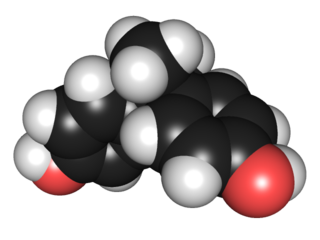
Phthalates, or phthalate esters, are esters of phthalic acid. They are mainly used as plasticizers, i.e., substances added to plastics to increase their flexibility, transparency, durability, and longevity. They are used primarily to soften polyvinyl chloride (PVC).

Phthalic anhydride is the organic compound with the formula C6H4(CO)2O. It is the anhydride of phthalic acid. Phthalic anhydride is a principal commercial form of phthalic acid. It was the first anhydride of a dicarboxylic acid to be used commercially. This white solid is an important industrial chemical, especially for the large-scale production of plasticizers for plastics. In 2000, the worldwide production volume was estimated to be about 3 million tonnes per year.
A plasticizer is a substance that is added to a material to make it softer and more flexible, to increase its plasticity, to decrease its viscosity, or to decrease friction during its handling in manufacture.

Bisphenol A (BPA) is a chemical compound primarily used in the manufacture of various plastics. It is a colourless solid which is soluble in organic solvents, but is only poorly soluble in water. It is produced on an industrial scale by the condensation of phenol and acetone, with global production in 2022 expected to reach 10 million tonnes.

Bis(2-ethylhexyl) phthalate (di-2-ethylhexyl phthalate, diethylhexyl phthalate, DEHP; dioctyl phthalate, DOP) is an organic compound with the formula C6H4(CO2C8H17)2. DEHP is the most common member of the class of phthalates, which are used as plasticizers. It is the diester of phthalic acid and the branched-chain 2-ethylhexanol. This colorless viscous liquid is soluble in oil, but not in water.

Benzyl butyl phthalate (BBP) is an organic compound historically used a plasticizer, but which has now been largely phased out due to health concerns. It is a phthalate ester of containing benzyl alcohol, and n-butanol tail groups. Like most phthalates, BBP is non-volatile and remains liquid over a wide range of temperatures. It was mostly used as a plasticizer for PVC, but was also a common plasticizer for PVCA and PVB.
Dibutyl sebacate (DBS) is an organic chemical, a dibutyl ester of sebacic acid. Its main use is as a plasticizer in production of plastics, namely cellulose acetate butyrate, cellulose acetate propionate, ethyl cellulose, polyvinyl butyral, polyvinyl chloride, polystyrene, and many synthetic rubbers and other plastics. It can be used for plastics in use in the food packaging industry, in plastics used for medical devices, and for pharmaceutical applications, e.g. as a plasticizer for film coating of tablets, beads, and granules. It is also used as a lubricant in shaving lotions, and a flavoring additive in non-alcoholic beverages, ice cream, ices, candy, and baked goods. It provides excellent compatibility with a range of plastic materials, superior properties at low temperatures, and good oil resistivity. Its other names include Morflex, Kodaflex, polycizer, Proviplast 1944 and PX 404. Dibutyl sebacate is also used as a desensitizer in Otto fuel II, a torpedo monopropellant.

Dimethyl phthalate is an organic compound and phthalate ester. it is a colourless and oily liquid that is soluble in organic solvents, but which is only poorly soluble in water.

Bis[2,4,5-trichloro-6-(pentyloxycarbonyl)phenyl]oxalate is a solid ester whose oxidation products are responsible for the chemiluminescence in a glowstick. It can be synthesized by reacting 2-carbopentoxy-3,5,6-trichlorophenol with oxalyl chloride.

Dibutyl phthalate (DBP) is an organic compound which is commonly used as a plasticizer because of its low toxicity and wide liquid range. With the chemical formula C6H4(CO2C4H9)2, it is a colorless oil, although commercial samples are often yellow.

Cellulose acetate phthalate (CAP), also known as cellacefate (INN) and cellulosi acetas phthalas, is a commonly used polymer phthalate in the formulation of pharmaceuticals, such as the enteric coating of tablets or capsules and for controlled release formulations. It is a cellulose polymer where about half of the hydroxyls are esterified with acetyls, a quarter are esterified with one or two carboxyls of a phthalic acid, and the remainder are unchanged. It is a hygroscopic white to off-white free-flowing powder, granules, or flakes. It is tasteless and odorless, though may have a weak odor of acetic acid. Its main use in pharmaceutics is with enteric formulations. It can be used together with other coating agents, e.g. ethyl cellulose. Cellulose acetate phthalate is commonly plasticized with diethyl phthalate, a hydrophobic compound, or triethyl citrate, a hydrophilic compound; other compatible plasticizers are various phthalates, triacetin, dibutyl tartrate, glycerol, propylene glycol, tripropionin, triacetin citrate, acetylated monoglycerides, etc.
In enzymology, a bis(2-ethylhexyl)phthalate esterase (EC 3.1.1.60) is an enzyme that catalyzes the chemical reaction

Diisononyl phthalate (DINP) is a phthalate used as a plasticizer. DINP is typically a mixture of chemical compounds consisting of various isononyl esters of phthalic acid, and is commonly used in a large variety of plastic items.

1,2-Cyclohexane dicarboxylic acid diisononyl ester (DINCH) is a mixture of organic compounds with the formula C6H10(CO2C9H19)2. DINCH is colorless oil. It is used as a plasticizer for the manufacture of flexible plastic articles in sensitive application areas such as toys, medical devices, and food packaging. It is of interest as an alternative for phthalate plasticizers, which are implicated as endocrine disruptors.

Diisodecyl phthalate (DIDP) is a commonly used plasticizer used in the production of plastic and plastic coating to increase flexibility. It is a mixture of compounds derived from the esterification of phthalic acid and isomeric decyl alcohols.

TCPO, or bis(2,4,6-trichlorophenyl) oxalate
Dioctyl terephthalate (bis(2-ethylhexyl) benzene-1,4-dicarboxylate or Di(2-ethylhexyl) terephthalate), commonly abbreviated DOTP or DEHT, is an organic compound with the formula C6H4(CO2C8H17)2. It is a non-phthalate plasticizer, being the diester of terephthalic acid and the branched-chain 2-ethylhexanol. This colorless viscous liquid used for softening PVC plastics is known for chemical similarity to general purpose phthalates such as DEHP and DINP, but without any negative regulatory pressure. It possesses very good plasticizing properties and may be used as a direct replacement for DEHP and DINP in many applications.

Conservation and restoration of objects made from plastics is work dedicated to the conservation of objects of historical and personal value made from plastics. When applied to cultural heritage, this activity is generally undertaken by a conservator-restorer.

Di(2-propylheptyl) phthalate (also known as bis(2-propylheptyl) benzene-1,2-dicarboxylate, di(propylheptyl) orthophthalate, or DPHP) is an organic compound with the formula C28H46O4. It is a phthalate and is the diester of phthalic acid and the 10-carbon branched-chain alcohol 2-propylheptanol. This colorless, viscous liquid is used for softening PVC plastics and is a general purpose PVC plasticizer. It possesses very good plasticizing properties and may be used as a direct replacement for DEHP and DINP in many applications.

Dibutoxy ethyl phthalate is an organic compound and phthalate ester, baring 2-butoxyethanol groups. It is used as a plasticizer in polyvinyl chloride, polyvinyl acetate and cellulose acetate. Like most phthalates it is non-volatile, and remains liquid over a wide range of temperatures. Although its water solubility is low, it remains one of the most water soluble of the common phthalates.

















